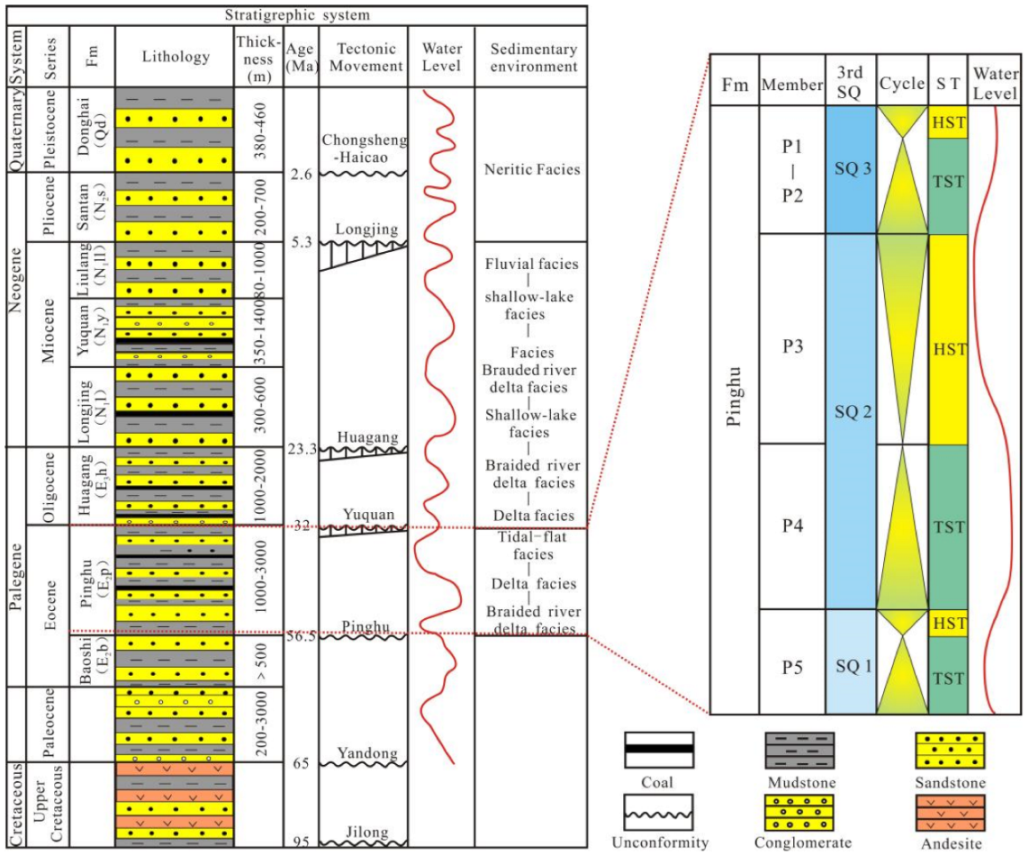Microscopic Characteristics and Formation Mechanism of Effective Reservoirs in the Xihu Depression, China: The Important Role of the Poikilotopic Calcite Cements in Tide-Dominated Delta Systems
Abstract
1. Introduction
2. Geological Setting
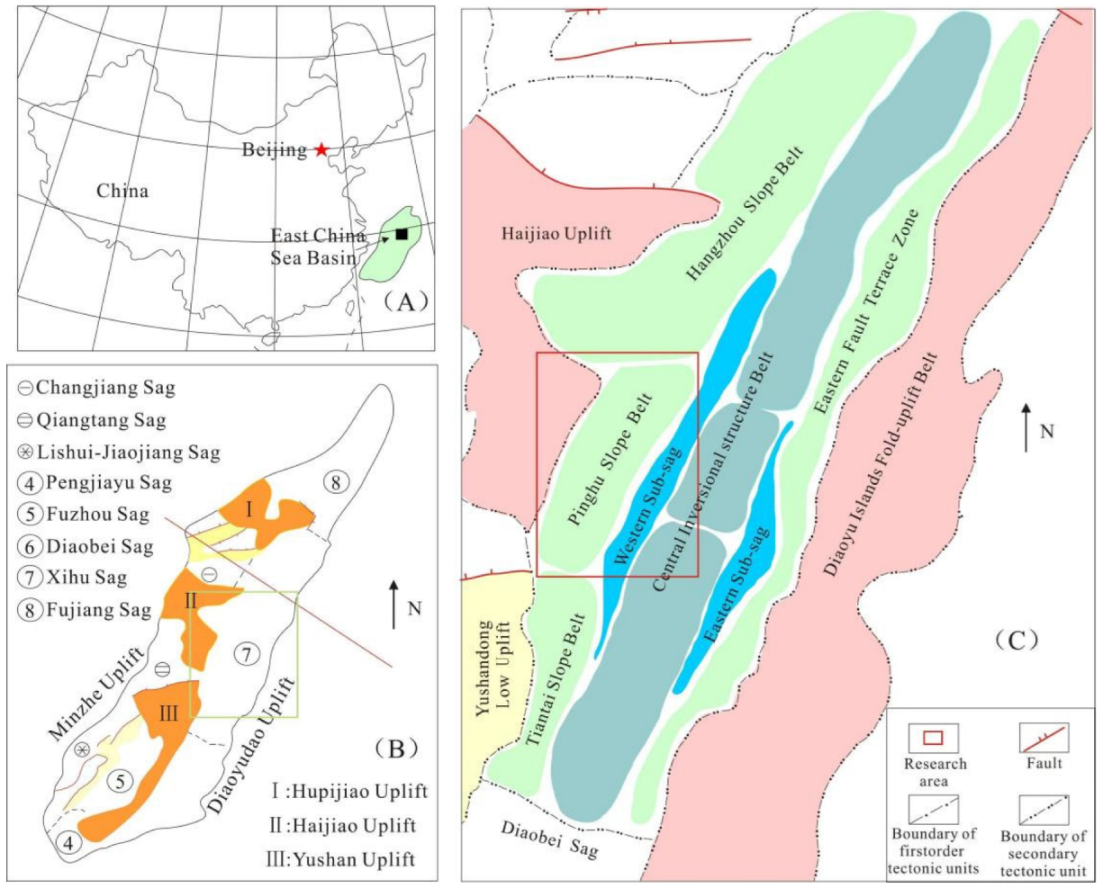
3. Samples and Methods
4. Results
4.1. Sandstone Petrology
4.2. Authigenic Minerals
4.3. Dissolution
4.4. Paragenesis
4.5. Effective Reservoir Characteristics
4.5.1. Microscopic Characteristics
4.5.2. Pore Structure Based on High-Resolution 3D CT Scanning
4.6. C and O Isotopic Data
5. Discussions
5.1. Formation Mechanism of Effective Reservoir
5.1.1. The Upper Conventional Reservoir (UC Reservoir)
5.1.2. The Lower Conventional Reservoir (LC Reservoir)
5.1.3. “Bottom Calcium” Low-Permeability Reservoir (“Bottom Calcium” Reservoir)
5.1.4. “MI Clay” Low-Permeability Reservoir (“MI Clay” Reservoir)
5.2. Vertical Distribution of the “Bottom Calcium” Reservoir and the UC Reservoir
5.3. Summary Model for the Diagenetic Alterations and Reservoir Quality Evolution
6. Conclusions
- The petrographic results suggest that the sandstones in the study area have undergone complex diagenetic processes. The dominant eogenetic features include the pervasive precipitation of early poikilotopic calcite cements in the high-energy zone. Subsequent mesogenetic events include: (i) the extensive dissolution of feldspars and calcite due to the emplacement of organic acids; (ii) the precipitation of kaolinites and quartz cements, and (iii) the late calcite, Fe-calcite and dolomite cements.
- UC reservoirs are characterized by high intergranular porosity, normal fine to very fine grains with point to long contacts. LC reservoirs are characterized by medium to coarse grains, extensive dissolution of feldspar and long or even concave–convex grain contacts. Compared with UC reservoirs, LC reservoirs have significantly lower quartz/feldspar ratios, which is related to differences in the number of feldspar reactions and the associated local secondary porosity. UC reservoirs normally develop in the middle of tidal channels and subaqueous distributary channels, with the base of the sand-body being extensively cemented by poikilotopic calcite cements and euhedral rhomb dolomite cements.
- Poikilotopic calcite cements normally develop in tidal channels and subaqueous distributary channels of tide-dominated delta. They may precipitate from diagenetic fluids of evolved mixed marine and meteoric waters that became hotter with progressive burial in the basin. The carbon sources of the “bottom calcium” calcite mostly originate from the dissolution of carbonate clasts and bioclast, while dolomite is more comparable to the generation of biogenic methane with high positive δ13C values.
- The eogenesis of poikilotopic calcite provided a framework to retard the adverse impacts of compaction in the P1–P3 Formation. For the lower laryers (P4–P5), poikilotopic calcite cementation is limited, and the secondary pores that are mostly formed by the dissolution of feldspar or unstable rock fragments and LC reservoirs can only develop in coarser sandstone, which limits their regional distribution.
Author Contributions
Funding
Data Availability Statement
Acknowledgments
Conflicts of Interest
References
- Anovitz, L.M.; Cole, D.R.; Rother, G.; Allard, L.F.; Jackson, A.J.; Littrell, K.C. Diagenetic changes in macro-to nano-scale porosity in the St. Peter Sandstone: An (ultra) small angle neutron scattering and backscattered electron imaging analysis. Geochem. Cosmochim. Acta 2013, 102, 280–305. [Google Scholar] [CrossRef]
- Anovitz, L.M.; Cole, D.R.; Jackson, A.J.; Rother, G.; Littrell, K.C.; Allard, L.F.; Pollington, A.D.; Wesolowski, D.J. Effect of quartz overgrowth precipitation on the multiscale porosity of sandstone: A (U) SANS and imaging analysis. Geochem. Cosmochim. Acta 2015, 158, 199–222. [Google Scholar] [CrossRef]
- Anovitz, L.M.; Cole, D.R. Characterization and analysis of porosity and pore structures. Rev. Mineral. Geochem. 2015, 80, 61–164. [Google Scholar] [CrossRef]
- Golab, A.N.; Knackstedt, M.A.; Averdunk, H.; Senden, T.; Butcher, A.R.; Jaime, P. 3D porosity and mineralogy characterization in tight gas sandstones. Lead. Edge 2010, 29, 1476–1483. [Google Scholar] [CrossRef]
- Lai, J.; Wang, G.; Fan, Z.; Zhou, Z.; Chen, J.; Wang, S. Fractal analysis of tight shaly sandstones using nuclear magnetic resonance measurements. AAPG Bull. 2018, 102, 175–193. [Google Scholar] [CrossRef]
- Oluwadebi, A.G.; Taylor, K.G.; Ma, L. A case study on 3D characterisation of pore structure in a tight sandstone gas reservoir: The Collyhurst Sandstone, East Irish Sea Basin, northern England. J. Nat. Gas Sci. Eng. 2019, 68, 102917. [Google Scholar] [CrossRef]
- Tsakiroglou, C.D.; Payatakes, A.C. Characterization of the pore structure of reservoir rocks with the aid of serial sectioning analysis, mercury porosimetry and network simulation. Adv. Water Resour. 2000, 23, 773–789. [Google Scholar] [CrossRef]
- Morad, S.; Al-Ramadan, K.; Ketzer, J.M.; De Ros, L.F. The impact of diagenesis on the heterogeneity of sandstone reservoirs: A review of the role of depositional facies and sequence stratigraphy. AAPG Bull. 2010, 94, 1267–1309. [Google Scholar] [CrossRef]
- Saigal, G.C.; Bjørlykke, K. Carbonate cements in clastic reservoir rocks from offshore Norway- relationships between isotopic composition, textural development and burial depth. Geol. Soc. Lond. Spec. Publ. 1987, 36, 313–324. [Google Scholar] [CrossRef]
- Bjørlykke, K.; Ramm, M.; Saigal, G.C. Sandstone diagenesis and porosity modification during basin evolution. Geol. Rundsch. 1989, 78, 243–268. [Google Scholar] [CrossRef]
- Taylor, T.R. The influence of calcite dissolution on reservoir porosity in Miocene sandstones, Picaroon Field, offshore Texas Gulf Coast. J. Sediment. Res. 1990, 60, 322–334. [Google Scholar]
- Dutton, S.P.; Willins, B.J.; White, C.D.; Bhattacharya, J.P. Outcrop characterization of reservoir quality and interwell-scale cement distribution in a tideinfluenced delta, Frontier Formation, Wyoming, USA. Clay Miner. 2000, 35, 95–105. [Google Scholar] [CrossRef]
- Longstaffe, F.J.; Calvo, R.; Ayalon, A.; Donaldson, S. Stable isotope evidence for multiple fluid regimes during carbonate cementation of the Upper Tertiary Hazeva Formation, Dead Sea Graben, southern Israel. J. Geochem. Explor. 2003, 80, 151. [Google Scholar] [CrossRef]
- Nyman, S.L.; Gani, M.R.; Bhattacharya, J.P.; Lee, K. Origin and Distribution of Calcite Concretions in Cretaceous Wall Creek Member, Wyoming: Reservoirquality implication for shallow-marine deltaic strata. Cretac. Res. 2014, 48, 139–152. [Google Scholar] [CrossRef]
- Liu, S.; Huang, S.; Shen, Z.; Lü, Z.; Song, R. Diagenetic fluid evolution and water-rock interaction model of carbonate cements in sandstone: An example from the reservoir sandstone of the Fourth Member of the Xujiahe Formation of the Xiaoquan-Fenggu area, Sichuan Province, China. Sci. China (Earth Sci.) 2014, 57, 1077–1092. [Google Scholar] [CrossRef]
- Xiong, D.; Azmy, K.; Blamey, N.J.F. Diagenesis and origin of calcite cement in the Flemish Pass Basin sand- stone reservoir (Upper Jurassic): Implications for porosity development. Mar. Pet. Geol. 2016, 70, 93–118. [Google Scholar] [CrossRef]
- Hesse, R.; Abid, A. Carbonate cementation-the key to reservoir properties of four sandstone levels (Cretaceous) in the Hibernia Oilfield, Jeanne d’Arc Basin, Newfoundland, Canada. Spec. Publ. Int. Assoc. Sedimentol. 1998, 26, 141–3600. [Google Scholar]
- Brown, D.M.; McAlpine, K.D.; Yole, R.W. Sedimentology and sandstone diagenesis of Hibernia Formation in Hibernia oil field, Grand Banks of Newfoundland. AAPG Bull. 1989, 73, 557–575. [Google Scholar]
- Baker, J.C.; Havord, P.J.; Martin, K.R.; Ghori, K.A.R. Diagenesis and petrophysics of the early Permian Moogooloo sandstone, southern Carnarvon basin, western Australia. AAPG Bull. 2000, 84, 250–265. [Google Scholar]
- McBride, E.F.; Picard, M.D.; Milliken, K.L. Calcite-cemented concretions in Cretaceous sandstone, Wyoming and Utah, USA. J. Sediment. Res. 2003, 73, 462–483. [Google Scholar] [CrossRef]
- Odigi, M.I.; Amajor, L.C. Geochemistry of carbonate cements in Cretaceous sandstones, southeast Benue Trough, Nigeria: Implications for geochemical evolution of formation waters. J. Afr. Earth Sci. 2010, 57, 213–226. [Google Scholar] [CrossRef]
- Azomani, E.; Azmy, K.; Blamey, N.; Brand, U.; Al-Aasm, I. Origin of Lower Ordovician dolomites in eastern Laurentia: Controls on porosity and implications from geochemistry. Mar. Pet. Geol. 2013, 40, 99–114. [Google Scholar] [CrossRef]
- García-García, F.; Marfil, R.; De Gea, G.A.; Delgado, A.; Kobstädt, A.; Santos, A.; Mayoral, E. Reworked marine sandstone concretions: A record of highfrequency shallow burial to exhumation cycles. Facies 2013, 59, 843–861. [Google Scholar] [CrossRef]
- Su, A.; Chen, H.H.; Chen, X.; He, C.; Liu, H.P.; Li, Q.; Wang, C.W. The characteristics of low permeability reservoirs, gas origin, generation and charge in the central and western Xihu depression, East China Sea Basin. J. Pet. Sci. Eng. 2018, 53, 94–109. [Google Scholar] [CrossRef]
- Wang, W.G.; Lin, C.Y.; Zhang, X.G.; Dong, C.M.; Ren, L.H.; Lin, J.L. Effect of burial history on diagenetic and reservoir-forming process of the Oligocene sandstone in Xihu sag, East China Sea Basin. Mar. Pet. Geol. 2020, 112, 104034. [Google Scholar] [CrossRef]
- Xu, F.H.; Xu, G.S.; Liu, W.; Cui, H.Y.; Wang, Y.R. Factors controlling the development of tight sandstone reser- voirs in the Huagang Formation of the central inverted structural belt in Xihu sag, East China Sea Basin. Pet. Explor. Dev. 2020, 47, 101–113. [Google Scholar] [CrossRef]
- Wang, W.G.; Lin, C.Y.; Zhang, X.G.; Dong, C.M.; Ren, L.H.; Lin, J.L. Provenance, clastic composition and their impact on diagenesis A case study of the Oligocene sandstone in the Xihu sag, East China Sea Basin. Mar. Pet. Geol. 2021, 126, 10490. [Google Scholar] [CrossRef]
- Zeng, F.; Dong, C.M.; Lin, C.Y.; Wu, Y.Q.; Tian, S.S.; Zhang, X.G.; Lin, J.L. Analyzing the effects of multiscale pore systems on reservoir Properties—A case study on Xihu Depression, East China Sea Shelf Basin, China. J. Pet. Sci. Eng. 2021, 203, 108609. [Google Scholar] [CrossRef]
- Duan, D.P.; Zhang, X.G.; Liu, B.B.; Lin, J.L.; Wang, W.G. The Relationship between Chlorite and Reservoir Quality in the Huagang Formation, Xihu Depression, China. Energies 2022, 15, 3438. [Google Scholar] [CrossRef]
- Qian, W.D.; Sun, Q.L.; Jones, S.J.; Yin, T.J.; Zhang, C.M.; Xu, G.S.; Hou, G.W.; Zhang, B. Diagenesis and controlling factors of Oligocene Huagang Formation tight sandstone reservoir in the south of Xihu sag, the East China Sea Shelf Basin. J. Pet. Sci. Eng. 2022, 215, 110579. [Google Scholar] [CrossRef]
- Wang, Y.X.; Chen, J.F.; Pang, X.Q.; Zhang, T.; Zhu, X.J.; Liu, K.X. Hydrocarbon generation and expulsion of tertiary coaly source rocks and hydrocarbon accumulation in the Xihu Sag of the East China Sea Shelf Basin, China. J. Asian Earth Sci. 2022, 229, 105170. [Google Scholar] [CrossRef]
- Zeng, F.; Dong, C.W.; Lin, C.Y.; Tian, S.S.; Wu, Y.Q.; Lin, J.L.; Liu, B.B.; Zhang, X.G. Pore structure characteristics of reservoirs of Xihu Sag in East China Sea Shelf Basin based on dual resolution X-ray computed tomography and their influence on permeability. Energy 2022, 239, 122386. [Google Scholar] [CrossRef]
- Jiang, L.; Tian, H.Q.; Ma, Y.X.; Zhao, Y.S. Petroleum System and Target Evaluation in Xihu Sag, East China Sea Shelf Basin; Petroleum University Publishing House: Dongying, China, 2000; pp. 16–133, (In Chinese with English abstract). [Google Scholar]
- Zhu, X.J.; Chen, J.F.; Li, W.; Pei, L.X.; Liu, K.X.; Chen, X.D.; Zhang, T.L. Hydrocarbon generation potential of Paleogene coals and organic rich mudstones in Xihu sag, East China Sea Shelf basin, offshore eastern China. J. Pet. Sci. Eng. 2020, 184, 106450. [Google Scholar] [CrossRef]
- Wang, W.G.; Lin, C.Y.; Zhang, X.G.; Dong, C.M.; Ren, L.H.; Lin, J.L. Structural controls on sandstone compa- cation within the anticline crest and flank An example from the Xihu Sag, East China Sea Basin. J. Pet. Sci. Eng. 2022, 211, 110157. [Google Scholar] [CrossRef]
- Li, S.X.; Shao, L.Y.; Liu, J.S.; Qin, L.Z.; Kang, S.L.; Eriksson, K.A.; Chen, X.D.; Yu, Z.K.; Liu, J.Z. Oil generation model of the liptinite-rich coals Palaeogene in the Xihu Sag, East China Sea Shelf Basin. J. Pet. Sci. Eng. 2022, 209, 109844. [Google Scholar] [CrossRef]
- Su, A.; Chen, H.H.; Lei, M.Z.; Li, Q.; Wang, C.W. Paleo-pressure evolution and its origin in the Pinghu slope belt of the Xihu Depression, East China Sea Basin. Mar. Pet. Geol. 2019, 107, 198–213. [Google Scholar] [CrossRef]
- Shen, Y.L.; Qin, Y.; Cui, M.; Xie, G.L.; Guo, Y.H.; Qu, Z.H.; Yang, T.Y.; Yang, L. Geochemical Characteristics and Sedimentary Control of Pinghu Formation (Eocene) Coal-bearing Source Rocks in Xihu Depression, East China Sea Basin. Acta Geol. Sin. (Engl. Ed.) 2021, 95, 91–104. [Google Scholar] [CrossRef]
- Yang, C.Q.; Yang, Y.Q.; Yang, C.S. Tectono-sedimentary evolution of the Mesozoic in the southern East China Sea Shelf Basin and its bearing on petroleum exploration. Mar. Geol. Quat. Geol. 2019, 39, 30–40, (In Chinese with English abstract). [Google Scholar]
- Xu, F. Characteristics of Caenozoic Structure and Tectonic Miaration of the East China Sea Shelf Basin. J. Oil Gas Technol. 2012, 34, 1–7, (In Chinese with English abstract). [Google Scholar]
- Mi, C.Y. The Fault Characteristics and Evolution of Central Inversion Tectonic Belt and Pinghu Slope in Xihu Sag. Master’s Thesis, Ocean University of China, Qingdao, China, 2015. (In Chinese with English abstract). [Google Scholar]
- Zhou, Z.Y.; Jiang, J.Y.; Liao, Z.T. Basin inverssion in Xihu depression, East China Sea. Gondwana Res. 2001, 4, 844–845, (In Chinese with English abstract). [Google Scholar]
- Li, C.F.; Zhou, Z.Y.; Ge, H.P. Rifting process of the Xihu depression, East China Sea Basin. Tectonophysics 2009, 472, 135–147, (In Chinese with English abstract). [Google Scholar] [CrossRef]
- Yu, Z.K.; Ding, F.; Zhao, H. Characteristics of structural evolution and classifcation of hydrocarbon migration and accumulation units in Xihu Sag, China. Shanghai Land Resour. 2018, 39, 75–78, (In Chinese with English abstract). [Google Scholar]
- Zhu, Y.; Yu, Y.F.; Zhang, T.; Zhang, S.I.; Tang, X.J. Geochemical characteristics of Tertiary coal- bearing source rocks in Xihu depression, East China Sea Basin. Mar. Pet. Geol. 2012, 35, 154–165. [Google Scholar] [CrossRef]
- Su, A.; Chen, J.H.; Wang, C.W.; Li, P.J.; Zhang, H.; Xiong, W.L.; Lei, M.Z. Genesis and maturity identification of oil and gas in the Xihu Sag, East China Sea Basin. Pet. Explor. Dev. 2013, 40, 521–527, (In Chinese with English abstract). [Google Scholar] [CrossRef]
- Abbas, A.; Zhu, H.T.; Zeng, Z.W.; Zhou, X.H. Sedimentary facies analysis using sequence stratigraphy and seismic sedimentology in the Paleogene Pinghu Formation, Xihu depression, East China Sea Shelf Basin. Mar. Pet. Geol. 2018, 93, 287–297. [Google Scholar] [CrossRef]
- Zhu, W.; Zhong, K.; Fu, X.; Chen, C.; Zhang, M.; Gao, S. The formation and evolution of the East China Sea Shelf Basin: A new view. Earth Sci. Rev. 2019, 190, 89–111. [Google Scholar]
- Zhao, L.N.; Chen, J.W.; Zhang, Y.G. Sedimentary characteristics of Pinghu Formation in Pinghu structural belt of Xihu depression, East China Sea. World Geol. 2008, 27, 42–47, (In Chinese with English abstract). [Google Scholar]
- Jiang, Y.M.; Diao, H.; Zeng, W.Q. Coal source rock conditions and hydrocarbon generation model of Pinghu Formation in Xihu Depression, East China Sea Basin. Bull. Geol. Sci. Technol. 2020, 39, 30–39, (In Chinese with English abstract). [Google Scholar]
- Liu, Y.H.; Cai, H.; Duan, D.P. The sedimentary characteristics of tidal delta and tidal flat in transgressive system tract of Pinghu Formation in Pinghu area, Xihu Sag. Mar. Geol. Front. 2020, 38, 33–40, (In Chinese with English abstract). [Google Scholar] [CrossRef]
- Lindholm, R.C.; Finkelman, R.B. Calcite staining; semiquantitative determination of ferrous iron. J. Sediment. Res. 1972, 42, 239–242. [Google Scholar] [CrossRef]
- McCrea, J.M. The isotopic chemistry of carbonates and a paleotemperature scale. J. Chem. Phys. 1950, 18, 849–857. [Google Scholar] [CrossRef]
- Xie, X.J.; Xiong, L.Q.; Chen, Y.; Li, L.Z.; Zhang, C.Y.; Bai, H.Q.; Liao, J.H. Low permeability reservoir characteristics and controlling factor of “Sweet Points” of Pinghu Formation in Xihu Sag. Sci. Technol. Eng. 2021, 21, 12890–12900, (In Chinese with English abstract). [Google Scholar]
- Xiao, X.X.; Qin, L.Z.; Zhang, W.; Jiang, X.; Xie, J.J. The origin of carbonate cements and the influence on reservoir quality of Pinghu Formation in Xihu Sag. Chin. J. Geol. 2021, 56, 1062–1076. [Google Scholar]
- Land, L.S. Oxygen and carbon isotopic composition of Ordovician brachio pods: Implications for coeval seawater: Discussion. Geochim. Cosmochim. Acta 1995, 59, 2843–2844. [Google Scholar] [CrossRef]
- Hutcheon, I.; Nahnybida, C.; Rouse, H.R.K. The geochemistry of carbonate cements in the Avalon sand, grand Banks of Newfoundland. Mineral. Mag. 1985, 49, 457–467. [Google Scholar] [CrossRef]
- Scotchman, I.C. The geochemistry of concretions from the Kimmeridge Clay Formation of southern and eastern England. Sedimentology 1991, 38, 79–106. [Google Scholar] [CrossRef]
- Denny, A.C.; Fall, A.; Orland, I.J.; Valley, J.W.; Eichhubl, P.; Laubach, S.E. A history of pore water oxygen isotope evolution in the cretaceous travis peak formation in East Texas. Geol. Soc. Am. Bull. 2020, 132, 1626–1638. [Google Scholar] [CrossRef]
- Friedman, I.; O’Neil, J.R. Compilation of Stable Isotope Fractionation Factors of Geochemical Interest; US Government Printing Office: Washington, DC, USA, 1977; Volume 49. [Google Scholar]
- Zheng, Y.F. Oxygen isotope fractionation in carbonate and sulfate minerals. Geochem. J. 1999, 33, 109–126. [Google Scholar] [CrossRef]
- Irwin, H.; Coleman, M.; Curtis, C.D. Isotopic evidence for source of diagenetic carbonates formed during burial of organic-rich sediments. Nature 1977, 269, 209–213. [Google Scholar] [CrossRef]
- Morad, S. Carbonate Cementation in Sandstones: Distribution Patterns and Geochemical Evolution; Wiley-Blackwell: Hoboken, NJ, USA, 1998; Volume 26, pp. 1–26. [Google Scholar]
- Faure, G.; Mensing, T.M. Isotopes: Principles and Applications; John Wiley & Sons Inc.: Hoboken, NJ, USA, 2005. [Google Scholar]
- Worden, R.H.; Morrall, G.T.; Kelly, S.; Mc Ardle, P.; Barshep, D.V. A renwed look at calcite cement in Marine-deltaic sandstones: The Brent Reservoir, Heather Field, Northern North Sea, UK. Geol. Soc. Spec. Publ. 2020, 484, 305–335. [Google Scholar] [CrossRef]
- Schultz, J.L.; Boles, J.; Tilton, G.R. Tracking calcium in the San Joaquin Basin, California: A strontium isotopic study of carbonate cements at North Coles Levee. Geochim. Cosochim. Acta 1989, 53, 1991–1999. [Google Scholar] [CrossRef]
- Mtys, S. Ferenc Molnr: The Plays and the Wives (Katalin Varge and Tams Gajd, eds). Hungrarian Q. 2007, 188, 122–129. [Google Scholar]
- Taylor, K.G.; Gawthorpe, R.L.; Curtis, C.D.; Marshall, J.D.; Awwiller, D.N. Carbonate cementation in a sequence-stratigraphic framework: Upper Cretaceous sandstones, Book Cliffs, Utah-Colorado. J. Sediment. Res. 2000, 70, 360–372. [Google Scholar] [CrossRef]
- Al-Ramadan, K.S.; Morad, J.N.; Proust, I.S.; Al-Aasm. Distribution of diagenetic alterations in siliciclastic shoreface deposits within a sequence stratigraphic framework: Evidence from the Upper Jurassic, Boulonnais, NW France. J. Sediment. Res. 2005, 75, 943–959. [Google Scholar] [CrossRef]
- Haynes, S.R.; Marshall, J.; Imsland-Wathne, E.; Minielly, G.; Mortlock, E.; Walderhaug, O.; Johnson, T. Depositional interpretation and reservoir characterization of the tithonian in mizzen F-09, Flemish Pass Basin, Canada. In Proceedings of Abstracts of Integration: CSEG, CSPG and CWLS GeoConvention; AAPG: Calgary, AB, Canada, 2013. [Google Scholar]
- Dutton, S.P. Calcite cement in Permian deep-water sandstones, Delaware Basin, west Texas: Origin, distribution, and effect on reservoir properties. AAPG Bull. 2008, 92, 765–787. [Google Scholar] [CrossRef]
- Zhao, Z.X.; Dong, C.M.; Zhang, X.G.; Lin, C.Y.; Huang, X.; Duan, D.P.; Lin, J.L.; Fang, Z.; Li, D. Reservoir controlling factors of the Paleogene Oligocene Huagang Formation in the north central part of the Xihu Depression, East China Sea Basin, China. J. Pet. Sci. Eng. 2019, 175, 159–172. [Google Scholar]
- Higgs, K.E.; Funnell, R.H.; Reyes, A.G. Changes in reservoir heterogeneity and quality as a response to high partial pressures of CO2 in a gas reservoir, New Zealand. Mar. Pet. Geol. 2013, 48, 293–322. [Google Scholar] [CrossRef]
- Wang, Y. Photophysical properties of fullerenes and fullerene/N, N-diethylaniline charge-transfer complexes. J. Phys. Chem. 1992, 96, 764–767. [Google Scholar] [CrossRef]
- Matlack, K.S.; Houseknecht, D.W.; Applin, K.R. Emplacement of clay into sand by infiltration. J. Sediment. Res. 1989, 59, 77–87. [Google Scholar]
- Moraes, M.A.S.; De Ros, L.F. Infiltrated clays in fluvial Jurassic sandstones of Recôncavo Basin, northeastern Brazil. J. Sediment. Res. 1990, 60, 809–819. [Google Scholar]
- Wolela, A.M.; Gierlowski-Kordesch, E.H. Diagenetic history of fluvial and lacustrine sandstones of the Hartford Basin (Triassic–Jurassic), Newark Supergroup, USA. Sediment. Geol. 2007, 197, 99–126. [Google Scholar] [CrossRef]
- Morad, S.; Ketzer, J.M.; De Ros, L.F. Spatial and temporal distribution of diagenetic alterations in siliciclastic rocks: Implications for mass transfer in sedimentary basins. Sedimentology 2000, 47, 95–120. [Google Scholar] [CrossRef]
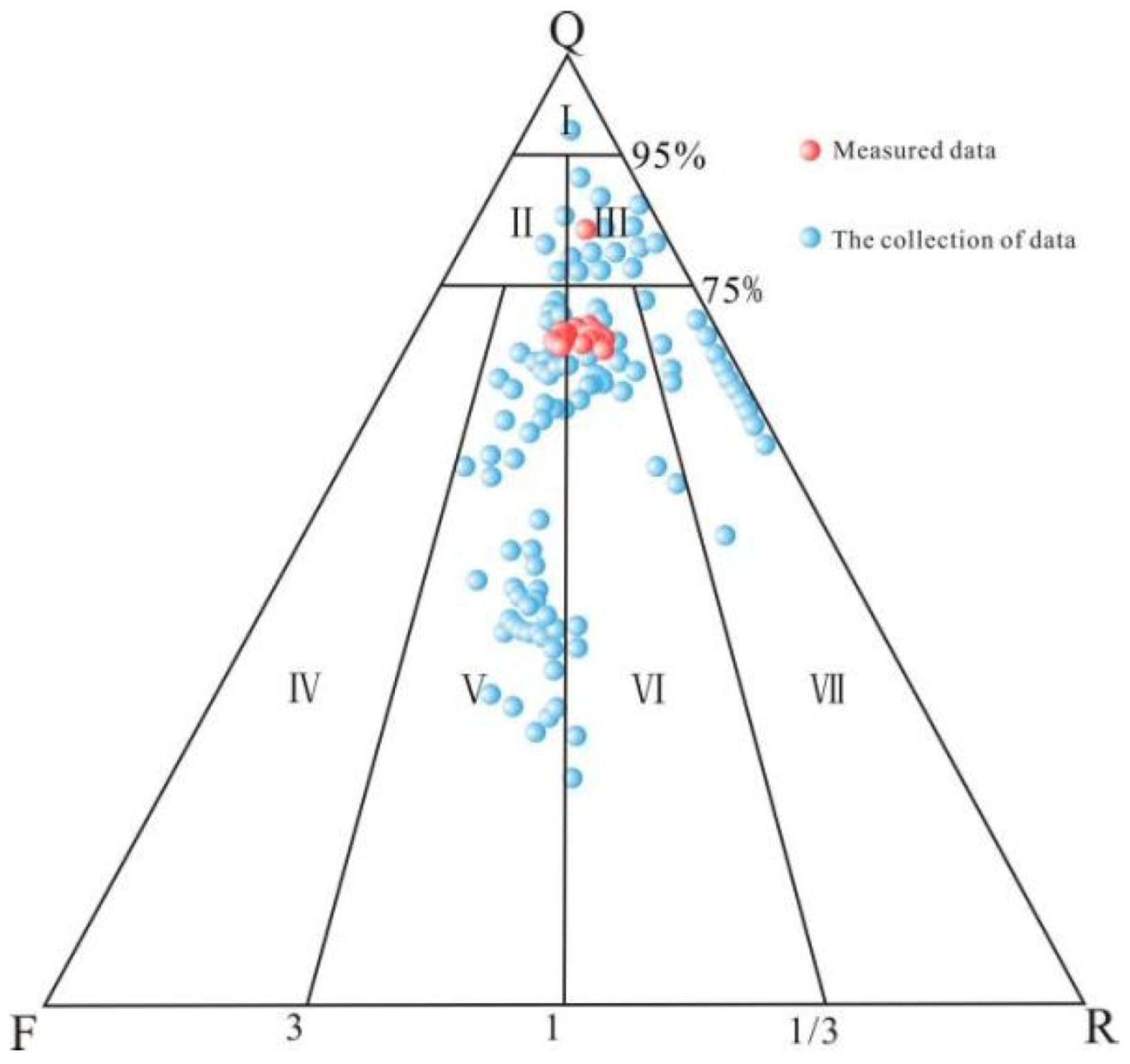
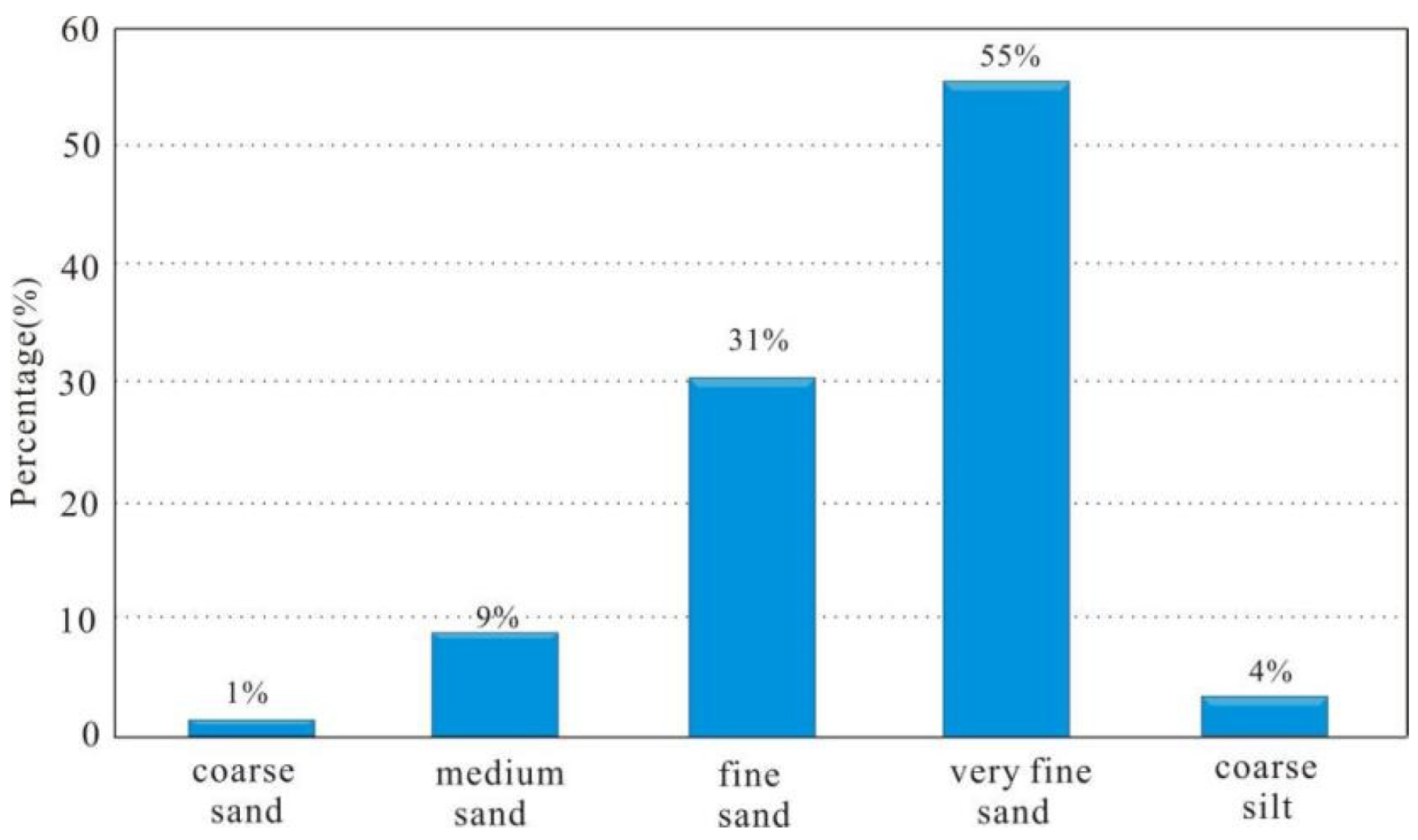
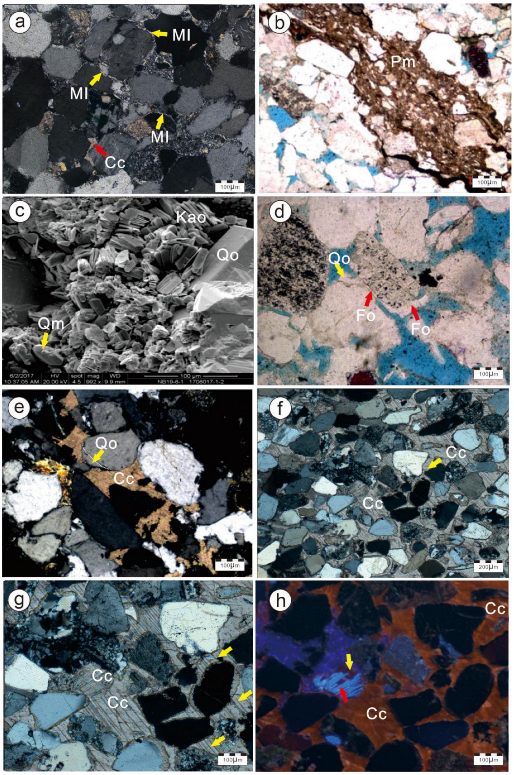
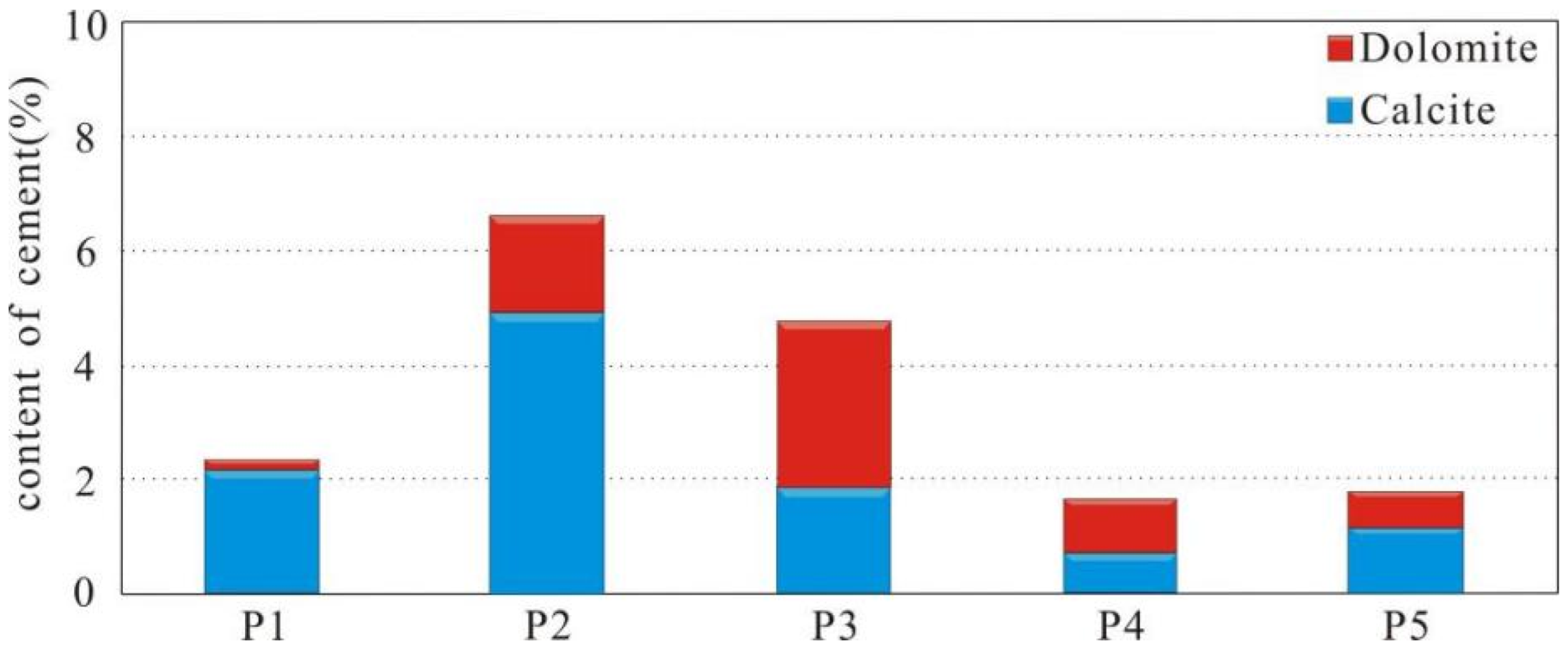

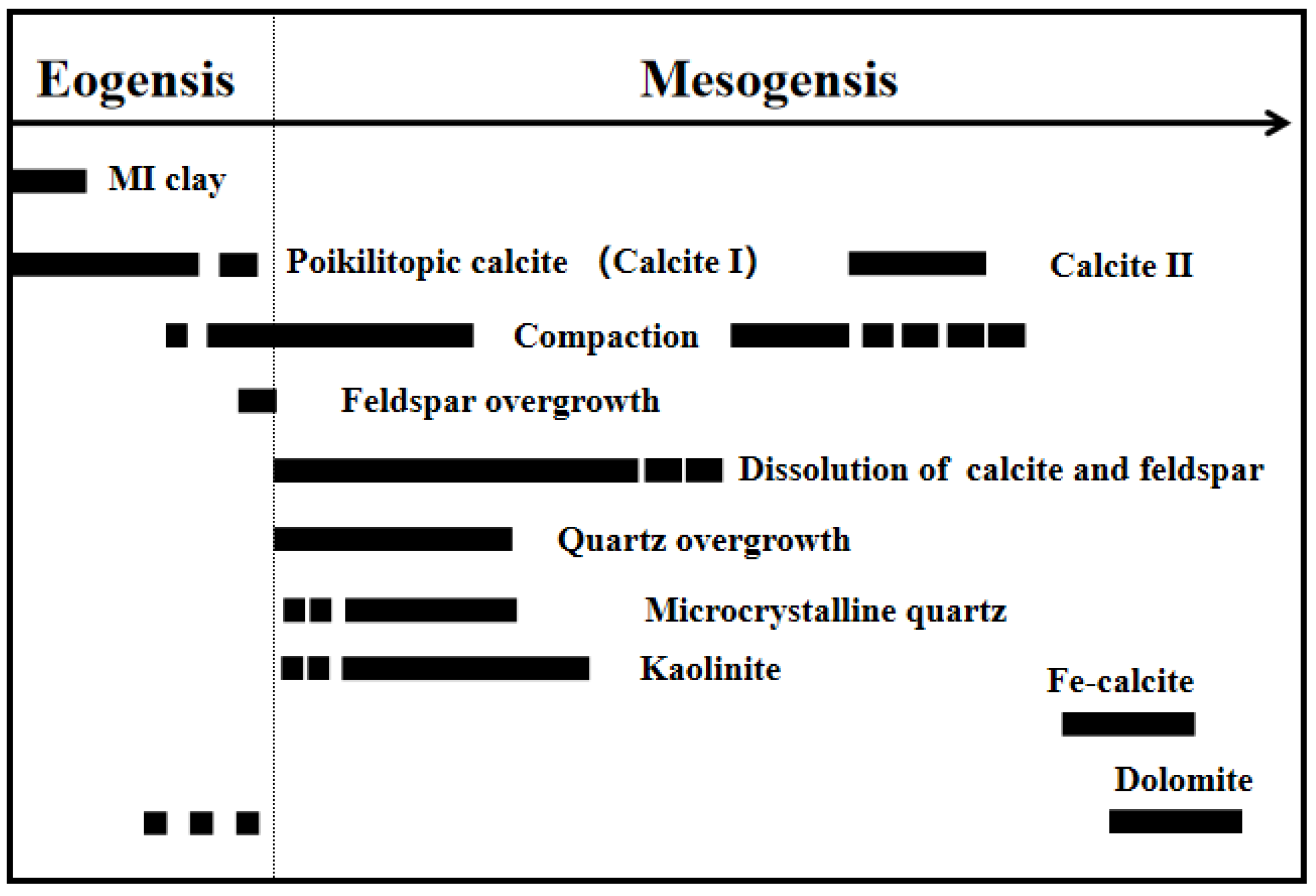
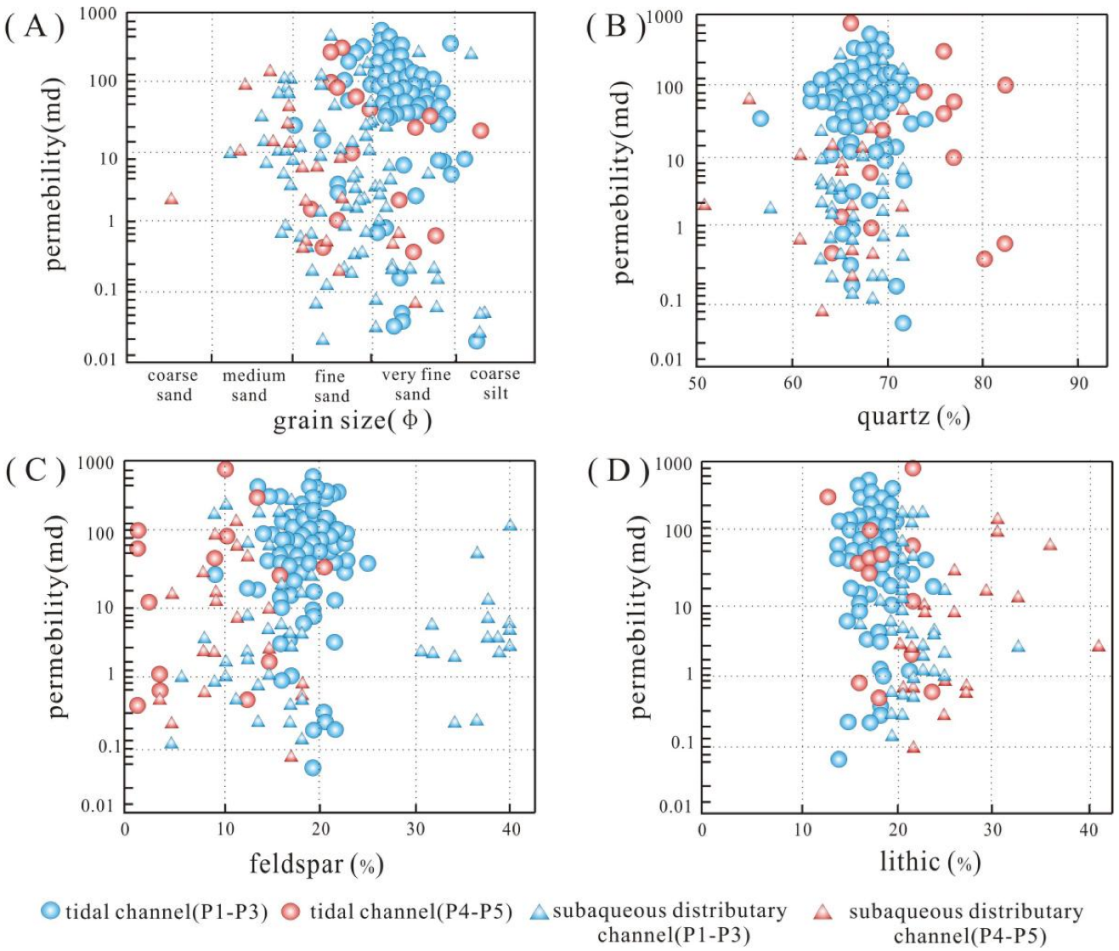
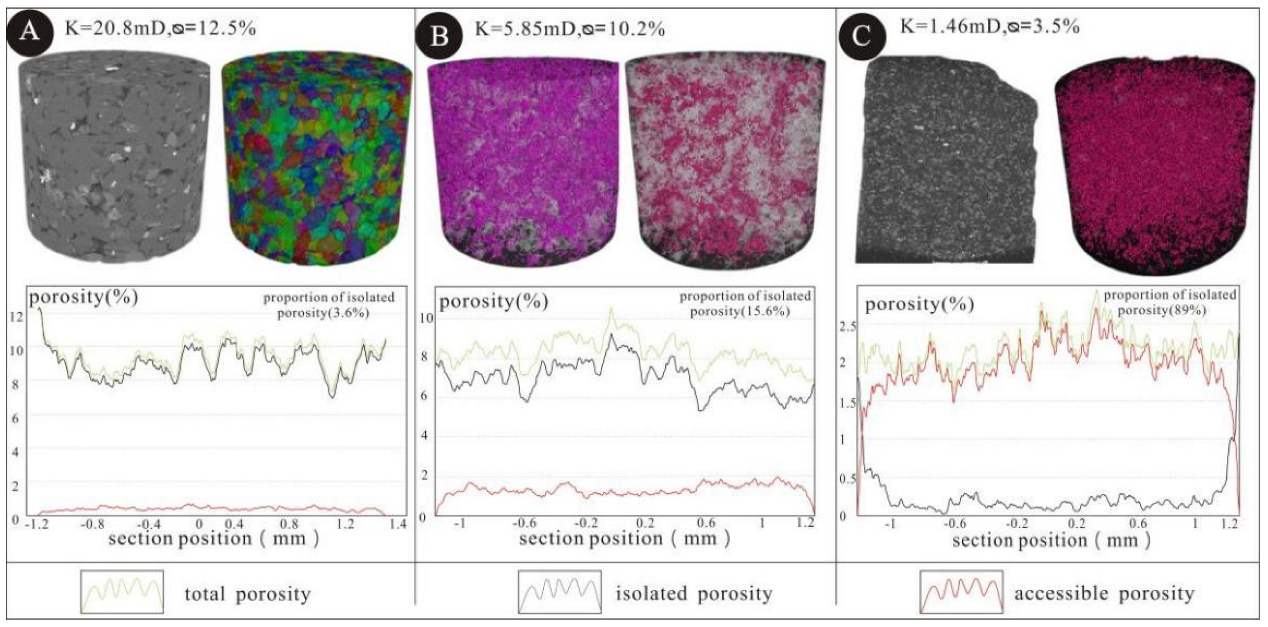
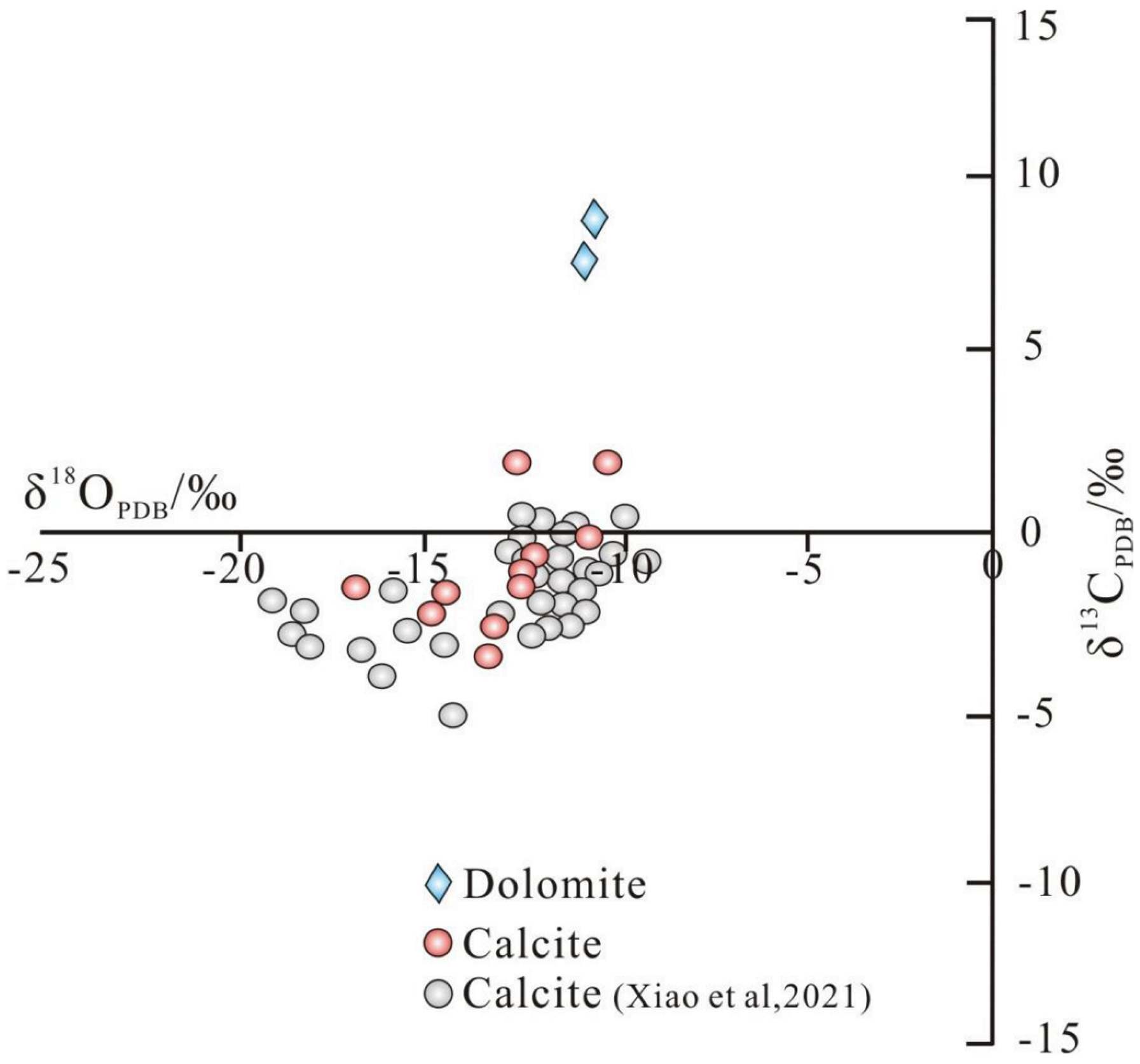
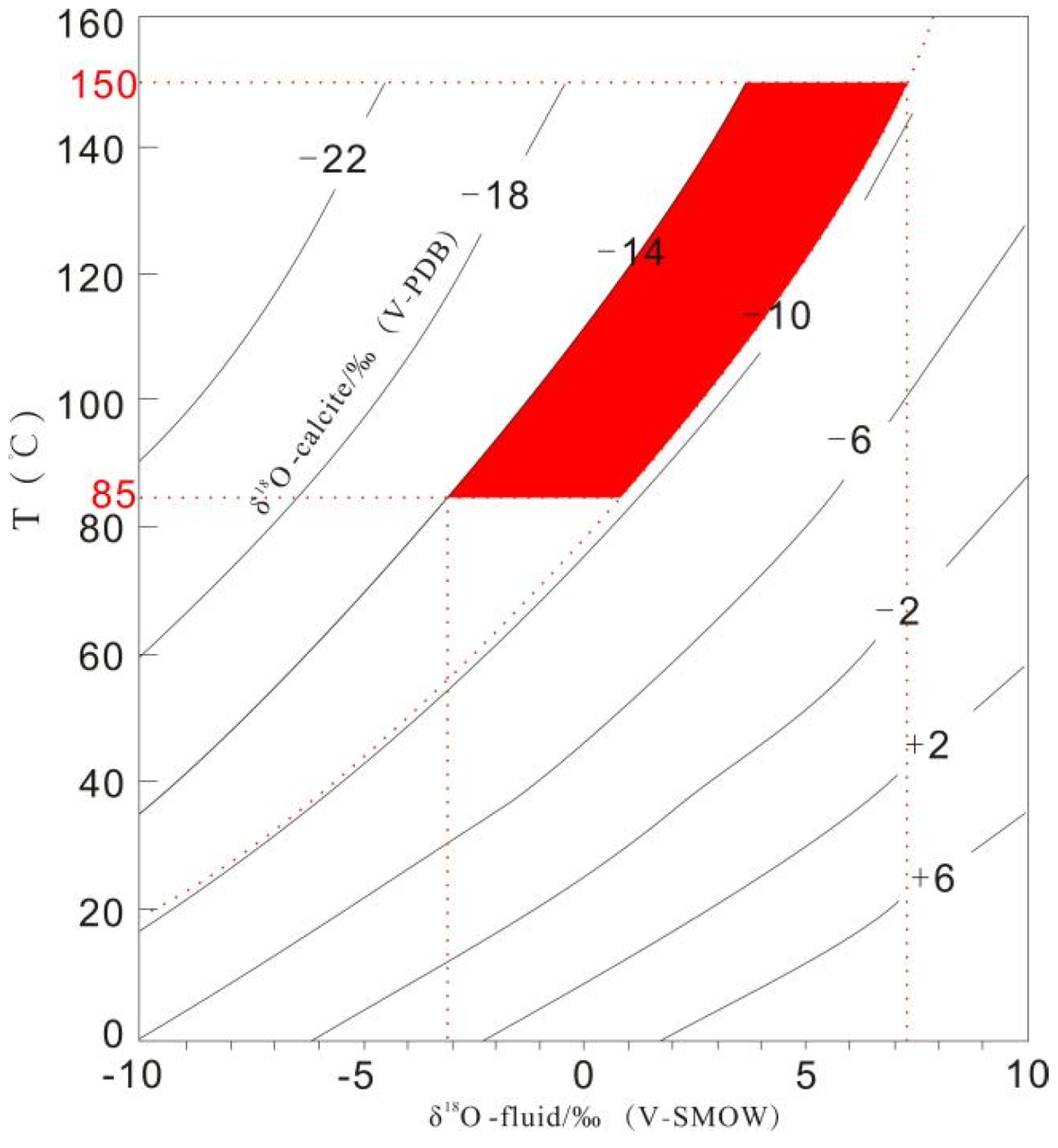


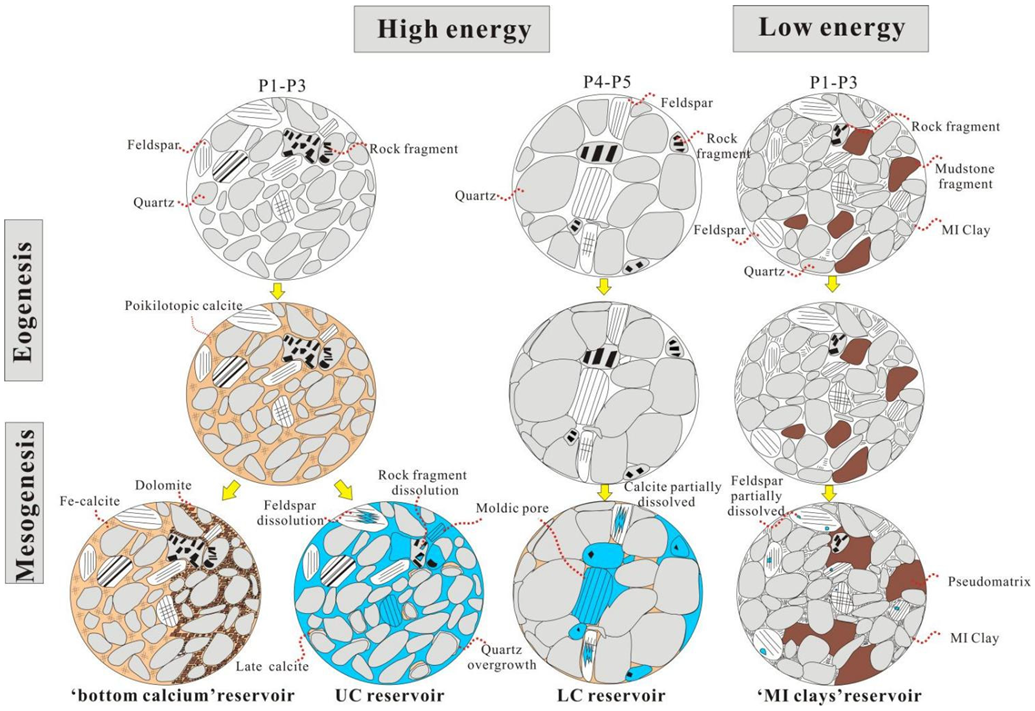
| Well | Depth (m) | Sedimentary Microfacies | Q (%) | Kp (%) | Pl (%) | Cc (%) | Dol (%) | Bit (%) | Clay (%) |
|---|---|---|---|---|---|---|---|---|---|
| A1 | 4202.46 | Subaqueous distributary channel | 61 | 12 | 23 | 0 | 0 | 1 | 3 |
| A1 | 4196.54 | Subaqueous distributary channel | 82 | 7 | 10 | 0 | 0 | 0 | 1 |
| A1 | 4202.77 | Subaqueous distributary channel | 82 | 2 | 3 | 2 | 0 | 0 | 1 |
| A1 | 4197.37 | Subaqueous distributary channel | 96 | 2 | 0 | 1 | 0 | 0 | 1 |
| A2 | 4183.87 | Tidal channel | 60 | 6 | 4 | 0 | 30 | 0 | 0 |
| A2 | 4183.62 | Tidal channel | 30 | 0 | 5 | 0 | 60 | 0 | 5 |
| A2 | 4186.50 | Tidal channel | 54 | 6 | 28 | 0 | 1 | 1 | 10 |
| A3 | 3445.29 | Tidal channel | 30 | 15 | 12 | 5 | 3 | 2 | 33 |
| A3 | 3446.57 | Tidal channel | 70 | 4 | 20 | 0 | 0 | 2 | 4 |
| A3 | 3447.27 | Tidal channel | 51 | 29 | 5 | 0 | 15 | 0 | 0 |
| A3 | 3443.67 | Tidal channel | 67 | 14 | 16 | 1 | 0 | 0 | 2 |
| A5 | 4088.16 | Mixed flat | 60 | 2 | 23 | 10 | 2 | 1 | 2 |
| A5 | 4089.26 | Mixed flat | 38 | 11 | 23 | 18 | 3 | 1 | 6 |
| A5 | 4087.06 | Tidal channel | 60 | 6 | 22 | 7 | 1 | 1 | 3 |
| A7 | 4348.82 | Subaqueous distributary channel | 40 | 5 | 29 | 14 | 2 | 2 | 8 |
| A7 | 4057.18 | Subaqueous distributary channel | 70 | 25 | 0 | 0 | 0 | 0 | 5 |
| A7 | 4055.64 | Subaqueous distributary channel | 67 | 30 | 0 | 0 | 0 | 0 | 3 |
| A8 | 4343.57 | Subaqueous distributary channel | 40 | 2 | 15 | 40 | 0 | 0 | 3 |
| A8 | 4340.74 | Subaqueous distributary channel | 49 | 4 | 24 | 9 | 1 | 1 | 12 |
| A8 | 4342.54 | Subaqueous distributary channel | 68 | 2 | 22 | 8 | 0 | 0 | 0 |
| A9 | 4220.00 | Subaqueous distributary channel | 50 | 5 | 10 | 12 | 14 | 0 | 7 |
| A9 | 4610.80 | Subaqueous distributary channel | 65 | 30 | 0 | 0 | 0 | 0 | 5 |
| A9 | 4612.10 | Subaqueous distributary channel | 58 | 10 | 15 | 3 | 1 | 1 | 12 |
| A9 | 4615.00 | Subaqueous distributary channel | 62 | 16 | 14 | 6 | 0 | 0 | 1 |
| Well | Depth (m) | Average Diameter of Pore (mm) | Diameter Standard Deviation of Pore (mm) | Accessible Volume (mm2) | Isolated Volume (mm2) | Total Volume (mm2) | Accessible Porosity (%) | Isolated Porosity (%) | Total Porosity (%) |
|---|---|---|---|---|---|---|---|---|---|
| A1 | 4196.54 | 0.03 | 0.02 | 1.42 | 0.62 | 1.48 | 9.04 | 0.39 | 9.44 |
| A5 | 4088.16 | 0.01 | 0.01 | 0.06 | 0.48 | 0.54 | 0.24 | 1.95 | 2.19 |
| A7 | 4057.18 | 0.12 | 0.01 | 0.87 | 0.16 | 1.00 | 7.00 | 1.30 | 8.30 |
| Number | Well | Depth (m) | Mineral | δ13CV-PDB (%) | δ18OV-PDB (%) | Z |
|---|---|---|---|---|---|---|
| 01 | A1 | 4202.77 | calcite | −1.4 | −17.5 | 115.72 |
| 02 | A2 | 4183.87 | dolomite | 9.3 | −11.1 | 140.82 |
| 03 | A2 | 4183.62 | dolomite | 8.4 | −11.4 | 138.83 |
| 04 | A3 | 3446.57 | calcite | −1.4 | −12.6 | 118.16 |
| 05 | A3 | 3447.27 | calcite | 2.5 | −10.2 | 127.34 |
| 06 | A5 | 4088.16 | calcite | −0.4 | −12.5 | 120.26 |
| 07 | A5 | 4089.26 | calcite | −3 | −15.3 | 113.54 |
| 08 | A5 | 4087.06 | calcite | 3.3 | −12.6 | 126.15 |
| 09 | A7 | 4348.82 | calcite | −2.7 | −16.1 | 113.75 |
| 10 | A9 | 4220.00 | calcite | −2.9 | −13.4 | 114.69 |
| 11 | A9 | 4610.80 | calcite | −0.5 | −12.3 | 120.15 |
| 12 | A9 | 4612.10 | calcite | −0.1 | −10.6 | 121.79 |
| 13 | A9 | 4615.00 | calcite | −3.3 | −14.1 | 113.52 |
| Depth (m) | Porosity (%) | Permeability (mD) | Grain Density | Sample Density |
|---|---|---|---|---|
| 4183.5 | 20.9 | 141 | 2.63 | 2.08 |
| 4183.6 | 14.6 | 10.9 | 2.71 | 2.31 |
| 4183.7 | 11.1 | 0.267 | 2.74 | 2.43 |
| 4183.8 | 8.8 | 0.203 | 2.73 | 2.49 |
| 4183.9 | 8.2 | 0.154 | 2.73 | 2.50 |
| 4184 | 3.3 | 2.71 | 2.81 | 2.72 |
Publisher’s Note: MDPI stays neutral with regard to jurisdictional claims in published maps and institutional affiliations. |
© 2022 by the authors. Licensee MDPI, Basel, Switzerland. This article is an open access article distributed under the terms and conditions of the Creative Commons Attribution (CC BY) license (https://creativecommons.org/licenses/by/4.0/).
Share and Cite
Zhang, S.; Wu, K.; Liu, N.; Peng, X.; Chen, Y. Microscopic Characteristics and Formation Mechanism of Effective Reservoirs in the Xihu Depression, China: The Important Role of the Poikilotopic Calcite Cements in Tide-Dominated Delta Systems. Minerals 2022, 12, 1413. https://doi.org/10.3390/min12111413
Zhang S, Wu K, Liu N, Peng X, Chen Y. Microscopic Characteristics and Formation Mechanism of Effective Reservoirs in the Xihu Depression, China: The Important Role of the Poikilotopic Calcite Cements in Tide-Dominated Delta Systems. Minerals. 2022; 12(11):1413. https://doi.org/10.3390/min12111413
Chicago/Turabian StyleZhang, Songxu, Keqiang Wu, Na Liu, Xiaolei Peng, and Ying Chen. 2022. "Microscopic Characteristics and Formation Mechanism of Effective Reservoirs in the Xihu Depression, China: The Important Role of the Poikilotopic Calcite Cements in Tide-Dominated Delta Systems" Minerals 12, no. 11: 1413. https://doi.org/10.3390/min12111413
APA StyleZhang, S., Wu, K., Liu, N., Peng, X., & Chen, Y. (2022). Microscopic Characteristics and Formation Mechanism of Effective Reservoirs in the Xihu Depression, China: The Important Role of the Poikilotopic Calcite Cements in Tide-Dominated Delta Systems. Minerals, 12(11), 1413. https://doi.org/10.3390/min12111413




